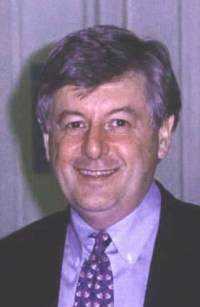Paul Frampton
| Paul Frampton | |
|---|---|
 UNC Faculty image of Paul Frampton uploaded in 2006 | |
| Born |
31 October 1943 Kidderminster, England |
| Residence | Chapel Hill |
| Fields | particle phenomenology |
| Institutions | UNC-Chapel Hill |
| Alma mater | Brasenose College, Oxford |
| Doctoral advisor | John C. Taylor |
| Known for | Model building |
Paul Frampton (born 31 October 1943) is a particle phenomenologist. Since 1996, he has been the Louis D. Rubin, Jr. Distinguished Professor of physics and astronomy, at the University of North Carolina in Chapel Hill. Born in Kidderminster, he attended King Charles I School, 1954–62, then Brasenose College, 1962–68. He received BA (Double First) in 1965, MA, DPhil in 1968, and DSc in 1984, degrees all from Oxford. He is a Fellow of the American Association for the Advancement of Science (1990) and the American Physical Society (1981). In 1987 he was the project director for siting the Superconducting Supercollider, in North Carolina. A Festschrift for his 60th birthday has been published.[1]
Research
His DPhil thesis analyzed the relationship between current algebra and superconvergence sum rules, and contained a 1967 sum rule. In 1970, he analyzed the absence of ghosts in the dual resonance model.
Three examples of his model building are the chiral color model, in 1987, which predicts axigluons; the 331 model, in 1992, which can explain the number of quark-lepton generations, and predicts bileptons; his proposal, in 1995, of the binary tetrahedral group as a flavor symmetry. All three serve as targets of opportunity for the Large Hadron Collider (LHC). In 2002, he built a model relating matter–antimatter asymmetry in the early universe to measurements possible on Earth.
In formal directions, three examples are that he calculated, in 1976, the rate of vacuum decay in quantum field theory; in 1982, he analyzed ten-dimensional gauge field theory, and its hexagon anomaly, precursor to the first superstring revolution; in 1988, he constructed the Lagrangian which describes the dynamics of the p-adic string.
For cosmology, two examples are, in 2007, he built a cyclic model which can solve a 75-year-old entropy problem; in 2010, he discussed how dark energy may be better understood by studying temperature and entropy.
Conviction
In November 2012, Frampton was convicted and sentenced to 56 months for drug smuggling in Argentina.[2] He claimed to have been the victim of a scam after supposedly meeting a model on a dating website, and that he had been tricked by gangsters into transporting cocaine hidden in the liner fabric of a suitcase.[3]
Publications
Frampton's first publication was Chirality Commutator and Vector Mesons, in 1967. He has published numerous articles on particle phenomenology. He was the author of a book[4] on string theory, in 1974 (2nd edition1986), when it was still named the dual resonance model. In 1986, he published a book[5] on quantum field theory (2nd edition 2000, 3rd edition 2008). A book[6] on cyclic cosmology, for the general public, was published in 2009.
He has published over 500 scientific articles, including:
- P.H. Frampton and Y. Nambu, Asymptotic Behavior of Partial Widths in the Veneziano Model of Scattering Amplitudes, in Quanta, Wentzel Festschrift, Chicago U.P. (1970)
- P.H. Frampton and T.W. Kephart, Explicit Evaluation of Anomalies in Higher Dimensions, Phys. Rev. Lett. 50, 1343, 1347 (1983); Phys. Rev. D28, 1010 (1983).
- P.H. Frampton and S.L. Glashow, Chiral Color-An Alternative to the Standard Model, Phys. Lett. 190B, 157 (1987).
- P.H. Frampton and Y. Okada, Effective Scalar Field Theory of p-Adic String, Phys. Rev. D37, 3077 (1988).
- P.H. Frampton, Chiral Dilepton Model and the Flavor Question, Phys. Rev. Lett. 69, 2889 (1992).
- P.H. Frampton and T.W. Kephart, Simple Non-Abelian Finite Flavor Groups and Fermion Masses, Int. J. Mod. Phys. 10A 4689-4704 (1995)
- P.H. Frampton, S.L. Glashow and T. Yanagida, Cosmological Sign of Neutrino CP Violation, Phys. Lett. B548 119 (2002).
- D.A. Easson, P.H. Frampton, and G.F. Smoot, Entropic Accelerating Universe, Phys. Lett. B696, 273 (2011).
- P.H. Frampton, K.J. Ludwick and R.J. Scherrer, The Little Rip, Phys. Rev. D84, 063003 (2011).
References
- ↑ Curtright, T.; Mintz, S.; Perlmutter, A. (2004). "La Belle Epoque of High Energy Physics and Cosmology". World Scientific Publishing Company.
- ↑ Banks, Michael (22 Nov 2012). "Paul Frampton hit by 56-month drugs sentence". Physics World. Institute of Physics. Retrieved 2013-04-02.
- ↑ Swann, Maxine (March 8, 2013). "The Professor, the Bikini Model and the Suitcase Full of Trouble". New York Times. Retrieved 18 March 2013.
- ↑ Frampton, P.H. (1974). Dual Resonance Models. Frontiers in Physics, W. A. Benjamin. ISBN 978-0-8053-2581-2.
- ↑ Frampton, P.H. (1986). Gauge field theories. Frontiers in Physics, Addison-Wesley. ISBN 978-0-471-34783-5.
- ↑ Frampton, P.H. (2009). Did Time Begin? Will Time End?: Maybe the Big Bang never occurred. World Scientific Publishing Company. ISBN 978-981-4280-58-7.
External links
- Professor Frampton's home page
- Paul Frampton's publications at Google Scholar
- Paul Frampton at the Mathematics Genealogy Project
|